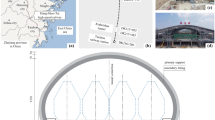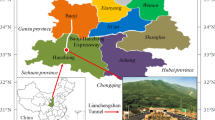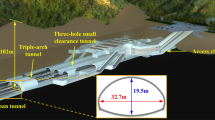Abstract
This paper presents a study of closely spaced double tunnels in Taizhou, China. One is Xiabei Mountain No. 2 four-line super-span high-speed railway tunnel (HRT), and the other is Xiabei Mountain double-line large-span subway tunnel (ST). The excavation spans of HRT and ST are 26.3 and 14 m, respectively. The two tunnels are located at different levels, and their separating distance is 17.2 m. Due to the short construction period, the HRT excavation was completed earlier than ST. The structural design of the HRT, taking account of the disturbance by the ST construction, was analyzed by a numerical simulation. It was found that the “yielding principle” design was more feasible than the “resistance principle” design when considering the safety and durability of the HRT secondary lining. The mechanical responses of the HRT during ST construction were comprehensively monitored and analyzed, including the vault settlement, horizontal convergence, surrounding rock pressure, and the internal stress in shotcrete and steel arch. Results show that the longitudinal influence range of the ST construction on the HRT was approximately 0.6–1.1 times the ST outer diameter; the disturbance was mainly generated in the ST upper bench excavation; and the final axial force of the HRT shotcrete was approximately 9–16 times that of the steel arch, which indicated that the shotcrete was the main bearing structure. The safety status of the HRT was assessed based on the monitoring data, and the minimum safety factors of the HRT shotcrete and steel arch were 1.61 and 1.89, respectively. Parametric studies were performed to show how the lining stress of HRT was affected by the relative angle, pillar width, ST excavation method and excavation footage. Finally, the design and construction optimization were proposed according to the monitoring data and parameter analysis results. This study might provide practical reference for similar projects.
Similar content being viewed by others
References
Li R, Zhang D L, Fang Q, Liu D P, Luo J W, Fang H C. Mechanical responses of closely spaced large span triple tunnels. Tunnelling and Underground Space Technology, 2020, 105: 103574
Luo J W, Zhang D L, Fang Q, Liu D P, Xu T. Mechanical responses of surrounding rock mass and tunnel linings in large-span triple-arch tunnel. Tunnelling and Underground Space Technology, 2021, 113: 103971
Wu L, Zhang X D, Zhang Z H, Sun W C. 3D discrete element method modelling of tunnel construction impact on an adjacent tunnel. KSCE Journal of Civil Engineering, 2020, 24(2): 657–669
Do N A, Dias D, Oreste P, Djeran Maigre I. Three-dimensional numerical simulation of a mechanized twin tunnels in soft ground. Tunnelling and Underground Space Technology, 2014, 42: 40–51
Tu H L, Zhou H, Qiao C S, Gao Y. Excavation and kinematic analysis of a shallow large-span tunnel in an up-soft/low-hard rock stratum. Tunnelling and Underground Space Technology, 2020, 97: 103245
Hage Chehade F, Shahrour I. Numerical analysis of the interaction between twin-tunnels: Influence of the relative position and construction procedure. Tunnelling and Underground Space Technology, 2008, 23: 210–214
Chen S L, Lee S C, Gui M W. Effects of rock pillar width on the excavation behavior of parallel tunnels. Tunnelling and Underground Space Technology, 2009, 24: 148–154
Das R, Singh P K, Kainthola A, Panthee S, Singh T N. Numerical analysis of surface subsidence in asymmetric parallel highway tunnels. Journal of Rock Mechanics and Geotechnical Engineering, 2017, 9: 170–179
Banerjee S K, Chakraborty D. Behavior of twin Tunnels under different physical conditions. International Journal of Geomechanics, 2018, 18(8): 06018018
Sahoo J P, Kumar J. Stability of long unsupported twin circular tunnels in soils. Tunnelling and Underground Space Technology, 2013, 38: 326–335
Boon C W, Ooi L H. Longitudinal and transverse interactions between stacked parallel tunnels constructed using shield tunnelling in residual soil. Geotechnical Engineering Journal of the SEAGS & AGSSEA, 2018, 49(2): 57–71
Li P, Wang F, Fan L, Wang H, Ma G. Analytical scrutiny of loosening pressure on deep twin-tunnels in rock formations. Tunnelling and Underground Space Technology, 2019, 83: 373–380
Choi J, Lee S. Influence of existing tunnel on mechanical behavior of new tunnel. KSCE Journal of Civil Engineering, 2010, 14(5): 773–783
Boonyarak T, Ng C W W. Effects of construction sequence and cover depth on crossing-tunnel interaction. Canadian Geotechnical Journal, 2015, 52(7): 851–867
Cooper M L, Chapman D N, Rogers C D F, Chan A H C. Movements in the Piccadilly Line tunnels due to the Heathrow Express construction. Geotechnique, 2002, 52(4): 243–257
Wang Z, Yao W, Cai Y, Xu B, Fu Y, Wei G. Analysis of ground surface settlement induced by the construction of a large-diameter shallow-buried twin-tunnel in soft ground. Tunnelling and Underground Space Technology, 2019, 83: 520–532
Golshani A, Varnusfaderani M G. Innovative design modification during construction of a twin tunnel using real-time field data. Transportation Geotechnics, 2019, 20: 100254
Huang Z, Zhang C, Fu H, Deng H, Ma S, Fu J. Numerical study on the disturbance effect of short-distance parallel shield tunnelling undercrossing existing tunnels. Advances in Civil Engineering, 2020, 2020(2): 1–14
Zhang D L, Fang Q, Hou Y, Li P, Yuen Wong L N. Protection of buildings against damages as a result of adjacent large-span tunneling in shallowly buried soft ground. Journal of Geotechnical and Geoenvironmental Engineering, 2013, 139(6): 903–913
Cantieni L, Anagnostou G. The interaction between yielding supports and squeezing ground. Tunnelling and Underground Space Technology, 2009, 24: 309–322
Zhou J, Yang X A, Cai J, Yang F. Distribution rules of loads on composite lining in deep-buried tunnels and mechanical solutions of loads. Chinese Journal of Rock Mechanics and Engineering, 2021, 40(5): 1009–1020 (in Chinese)
Song C Y, Tu H L, Qiao C S. Analysis on combination mode and parameters of primary support of shallow-buried large-span tunnel: Case study on Xinggongjie station tunnel on No. 2 line of Dalian metro. Tunnel Construction, 2015, 35(6): 491–499 (in Chinese)
Marinos P, Hoek E. GSI: A geologically friendly tool for rock mass strength estimation. In: GeoEng 2000. Melbourne: Taylor & Francis, 2000
Hoek E, Brown E T. The Hoek-Brown failure criterion and GSI—2018 edition. Journal of Rock Mechanics and Geotechnical Engineering, 2019, 11: 445–463
Zhang H J, Qiu W G, Qing W C. Study on distribution of axial forces of systematic anchor bars in tunnel multi-partition excavation. Journal of the China Railway Society, 2013, 35(12): 90–94 (in Chinese)
TB10003-2016. Code for Design on Railway Tunnel. Beijing: China Railway Publishing House Co., Ltd., 2016 (in Chinese)
Hibbeler R C. Statics and Mechanics of Materials. Upper Saddle River: Prentice Hall, 2014
Luo J, Zhang D, Fang Q, Li A, Sun Z, Cao L. Analytical study on pretensioned bolt-cable combined support of large cross-section tunnel. Science China. Technological Sciences, 2020, 63(9): 1808–1823
Sterpi D, Cividini A. A Physical and numerical investigation on the stability of shallow tunnels in strain softening media. Rock Mechanics and Rock Engineering, 2004, 37(4): 277–298
Acknowledgements
The authors gratefully acknowledge the support provided by the China Railway Bridge Bureau Group (No. CL19048530); the China Railway Design Group (No. 721602). In addition, the authors thank American Journal Experts (AJE) for its linguistic assistance during the preparation of this manuscript. No conflict of interest exists in the submission of the manuscript.
Author information
Authors and Affiliations
Corresponding author
Rights and permissions
About this article
Cite this article
He, J., He, S., Liu, X. et al. Structural design and mechanical responses of closely spaced super-span double tunnels in strongly weathered tuff strata. Front. Struct. Civ. Eng. 16, 685–703 (2022). https://doi.org/10.1007/s11709-022-0824-2
Received:
Accepted:
Published:
Issue Date:
DOI: https://doi.org/10.1007/s11709-022-0824-2




